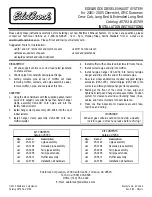
2. Keep your foot on the brake pedal and turn the ignition key to
ON.
3. DO NOT depress the accelerator pedal when starting your
engine. DO NOT use the accelerator while the vehicle is
parked.
4. Turn the key to the START position (cranking) until the engine
starts. Allow the key to return to the ON position after the
engine has started.
If you have difficulty in turning the key, rotate the steering
wheel slightly because it may be binding.
For a cold engine:
m
At temperatures 10° F (-12° C) and below: If the engine does
not start in fifteen (15) seconds on the first try, turn the key
to OFF, wait approximately ten (10) seconds so you do not flood
the engine, then try again.
m
At temperatures above 10° F (-12° C): If the engine does not
start in five (5) seconds on the first try, turn the key to OFF,
wait approximately ten (10) seconds so you do not flood the
engine, then try again.
For a warm engine:
m
Do not hold the key in the START position for more than five
(5) seconds
at a time. If the engine does not start within five
(5) seconds on the first try, turn the key to the OFF position. Wait
a few seconds after the starter stops, then try again.
Whenever you start your vehicle, release the key as soon as the
engine starts. Excessive cranking could damage the starter.
After you start the engine, let it idle for a few seconds. Keep
your foot on the brake pedal
and release the parking brake. Put
the gearshift lever in gear, slowly release the brake pedal and
drive away in the normal manner.
208
Summary of Contents for Villager
Page 2: ...Copyright 1997 Ford Motor Company ...
Page 4: ......
Page 12: ...Mechanical cluster 8 ...
Page 26: ...Electronic cluster 22 ...
Page 34: ...Electronic AM FM Stereo Cassette Radio 30 ...
Page 35: ...Premium Sound Radio Electronic Sound Syst ...
Page 36: ...Supersound with CD Changer 32 ...
Page 56: ...Notes 52 ...
Page 58: ...Instrument Panel Instrument panel 54 ...
Page 124: ...Notes 120 ...
Page 138: ...Using the seat belt guide with the three passenger bench seat in the second row position 134 ...
Page 176: ...2 If connected unbuckle the two safety belt tongues Also detach the chest clip 172 ...
Page 184: ...180 ...
Page 199: ...Adjustable Rear Seating 195 ...
Page 210: ...Notes 206 ...
Page 218: ...Notes 214 ...
Page 244: ...Notes 240 ...
Page 250: ...246 ...
Page 251: ...Roadside Emergencies 247 ...
Page 255: ...Roadside Emergencies 251 ...
Page 275: ...Sequence for connecting jumper cables Roadside Emergencies 271 ...
Page 278: ...Notes 274 ...
Page 325: ...Bulb locations Maintenance and Care 321 ...
Page 326: ...Bulb replacement chart 322 ...
Page 327: ...Maintenance and Care 323 ...
Page 328: ...324 ...
Page 329: ...Maintenance and Care 325 ...
Page 330: ...326 ...
Page 331: ...Maintenance and Care 327 ...
Page 332: ...328 ...
Page 340: ...Notes 336 ...
Page 342: ...338 ...
Page 343: ...Lubricant Specifications Automatic Transmission Fluid Capacities and Specifications 339 ...
Page 344: ...340 ...
Page 346: ...The engine compartment 342 ...
Page 348: ...Notes 344 ...
Page 363: ...Accessories 359 ...
Page 364: ...Notes 360 ...
Page 365: ...Notes Accessories 361 ...
Page 366: ...Notes 362 ...
Page 367: ...363 Q U I C K I N D E X ...
Page 368: ...Front Exterior View 364 ...
Page 369: ...Rear Exterior View ...
Page 370: ...Entrance View 366 ...
Page 371: ...Driver s Door ...
Page 372: ...Instrument Cluster Electronic 368 ...
Page 373: ...Instrument Panel ...
Page 374: ...Instrument Cluster Standard 370 ...
Page 375: ...Cargo Compartment ...
Page 376: ...Engine Compartment 372 ...
Page 396: ......
Page 397: ......
Page 398: ......
Page 399: ......
Page 400: ...Service Station Information 400 ...
















































